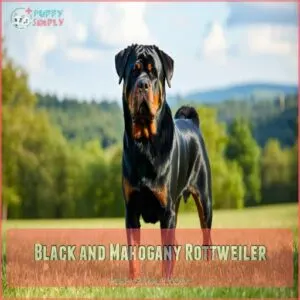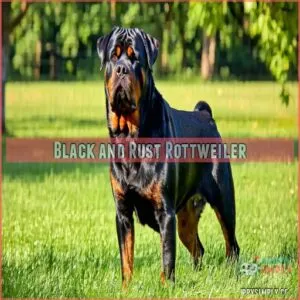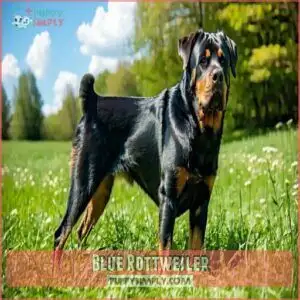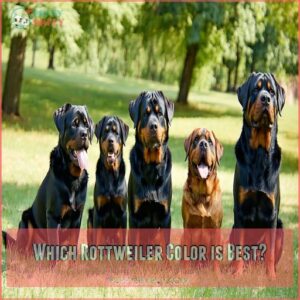This site is supported by our readers. We may earn a commission, at no cost to you, if you purchase through links.
 Rottweiler colors are as striking as the breed itself!
Rottweiler colors are as striking as the breed itself!
The standard options—Black and Mahogany, Black and Rust, and Black and Tan—are all recognized by the American Kennel Club and feature a sleek black base coat paired with rich markings.
These markings, like those "eyebrow dots" or chest triangles, give the Rottie its signature look.
Rare colors like Red and Blue may look unique but are tied to health issues, making their appeal more complicated.
Overall, Rottweiler coats are more than just eye-catching—they reflect this breed’s strength and elegance.
Curious about their care or patterns? There’s more to uncover!
Table Of Contents
- Key Takeaways
- What Are The Rottweiler Colors?
- The 5 Rottweiler Color Overview
- Rottweiler Markings and Patterns
- Rottweiler Health Issues
- Do Rottweilers Change Colors?
- Which Rottweiler Color is Best?
- Frequently Asked Questions (FAQs)
- What color is a Rottweiler’s coat?
- What does a blue Rottweiler look like?
- Do Rottweilers come in different colors?
- What color is a black tan Rottweiler?
- What color is a rust Rottweiler?
- What color is a Rottweiler at a dog show?
- What is the rarest color of Rottweiler?
- What are the 3 types of Rottweiler?
- How much does a 100% Rottweiler cost?
- Why are Rottweilers so clingy?
- Conclusion
Key Takeaways
- You’ll find three standard Rottweiler colors recognized by the American Kennel Club: black and mahogany, black and rust, and black and tan.
- Rare Rottweiler colors like red and blue exist but often come with genetic health risks, so they’re not recommended for responsible breeding.
- Rottweiler markings, such as eyebrow dots, chest triangles, and muzzle stripes, are a signature feature and contribute to their striking appearance.
- Coat health and color intensity depend on factors like grooming, proper nutrition, and protection from sun exposure.
What Are The Rottweiler Colors?
Rottweiler colors are as striking as the breed itself.
You’ll find three standard options recognized by the American Kennel Club: Black and Mahogany, Black and Rust, and Black and Tan.
Each of these showcases a jet-black base coat paired with sharply defined secondary markings.
These Rottweiler markings include muzzle stripes, chest triangles, and those adorable “eyebrow” dots.
Ever wonder why some Rottweilers have these specific patterns?
It’s all thanks to Coat Color Genetics, which balance pigment intensity and placement.
For more on Rottweiler big and puppy development, understanding the genetic basis is key.
Though the Rottweiler breed sticks to these standards for competition, some rare variations like red or blue pop up too—though they’re often linked to health concerns.
And yes, puppy coats can shift slightly as they grow, adding to the mystery!
The 5 Rottweiler Color Overview
Regarding Rottweiler colors, you’ve got five unique options to explore, ranging from classic to rare.
Each color combination has its own charm, but some are more common—and healthier—than others.
Black and Mahogany Rottweiler
When considering Rottweiler colors, the black and mahogany variation is a head-turner.
This timeless combo features a shiny black coat paired with rich mahogany tones that highlight areas like the chest, muzzle, legs, and above the eyes.
Recognized by breed standards, Black Rottweilers with this mahogany shade are the picture of elegance.
For more information on official colors, to fully understand the breed standards and genetics that make these color variations truly stunning,
is key.
Want to bring out the best in their coat?
Follow these tips:
- Brush daily to maintain the sleek black coat and vibrant mahogany accents.
- Stick to high-quality dog food, as diet affects coat health.
- Avoid over-bathing—natural oils keep that glossy finish.
Rottweiler genetics make these color variations truly stunning!
Black and Rust Rottweiler
There’s something striking about the black and rust Rottweiler.
Its gleaming black base coat perfectly highlights the rich rust markings, found around the muzzle, above the eyes, and on the chest and legs.
This classic pairing meets breed standards and stands out for its bold color contrast.
The rust color genetics guarantee these markings don’t exceed 10% of its coat, creating a balanced, elegant look.
With proper black coat care, these Rottweiler coat colors truly shine.
For owners, a Black Rust accessory can complement their pet’s appearance.
Black and rust? A timeless favorite among Rottweiler enthusiasts!
Black and Tan Rottweiler
Moving from the bold rust markings, the black and tan Rottweiler boasts a subtle yet striking look.
Its solid black coat pairs beautifully with tan points on the muzzle, chest, legs, and above the eyes.
These markings, often nicknamed "eyebrow dots," add personality to this rare combination within the Rottweiler breed.
The tan tones are lighter than mahogany or rust but still meet breed standards.
The black masks and sharply defined coat patterns make these Rottweilers stand out.
For owners and enthusiasts of the Black Tan Rottweiler, understanding the genetics behind this coat is essential for proper care.
With proper care, this coat type shines like polished onyx, showcasing the timeless elegance of Rottweiler genetics and the rich variety of Rottweiler colors.
Red Rottweiler
The Red Rottweiler stands out with its unique reddish-brown coat, a result of rare genetics often linked to unethical breeding practices.
While stunning, they’re not recognized within standard Rottweiler colors due to health concerns and temperament risks. These rare colors can attract attention, but it’s key to focus on responsible care.
Red puppies might inherit issues like joint problems or heart conditions, so always prioritize health over aesthetics. For those interested in Red Rottweiler puppies care, understanding their specific needs is essential.
Despite their rarity, their loyal Rottweiler temperament remains—a mix of love, strength, and unmatched companionship.
Blue Rottweiler
A Blue Rottweiler stands out with its unique dilute coat, showcasing shades from slate gray to navy blue.
This rare breed results from a coat mutation affecting pigment, known as color dilution.
However, Blue Rottweilers often face health issues like Rottweiler alopecia and hip dysplasia.
If you’re considering this rare color, prioritize ethical breeders and careful health screening.
Rottweiler Markings and Patterns
Rottweilers are famous for their striking markings that highlight their strong and confident look.
Their saddle patterns, eye dots, muzzle marks, and chest marks are like works of art shaped by nature.
Each standard Rottweiler features precise color and marking patterns that define their elegance.
- Saddle Patterns: The signature black shading over the back.
- Eye Dots: Bright, expressive spots above each eye.
- Chest Marks: Symmetrical triangular shapes on the chest.
These distinctive Rottweiler markings stand out, making every dog uniquely remarkable.
Rottweiler Health Issues
Staying ahead of Rottweiler health issues is key to keeping your pup happy and active.
Common genetic disorders like hip and elbow dysplasia can cause discomfort, so regular veterinary care is a must. Look out for heart conditions, such as aortic stenosis, or potential disease risks like bloat and cancer.
Understanding the rottweilers dog breed can help you identify potential health issues early on.
Good nutrition, consistent exercise, and early disease prevention can make a huge difference. Small changes, like lighter muzzle patches, might seem minor but should be monitored.
Healthy habits guarantee your canine companion thrives.
Do Rottweilers Change Colors?
Ever noticed how Rottweiler colors seem to shift over time? It’s not just your imagination! Their coat transformation can be influenced by genetics, environment, and age.
Their coat transformation is a complex process that can be managed with proper care. Here’s what you can do to maintain those striking markings:
- Protect against sun exposure – Too much UV can fade the coat.
- Feed a nutritious diet – Lack of nutrients can dull their fur.
- Stick to regular grooming – Brushing spreads oils and keeps the coat healthy.
From puppy development to seasonal changes, even small actions keep their look sharp!
Which Rottweiler Color is Best?
Choosing the "best" Rottweiler color often boils down to personal preference and breed standards.
Among recognized Rottweiler coat colors, Black and Mahogany tends to steal the show.
Its rich, dark hues paired with well-defined markings perfectly align with what the American Kennel Club expects, making it the go-to choice for many enthusiasts.
The Black and Tan variation is another classic, offering a slightly lighter tone without losing the signature elegance of the breed.
However, rare Rottweiler colors like Red and Blue might catch your eye, but keep in mind, these often come with genetic health concerns, like alopecia or joint issues.
Understanding the rottweilers dog breed is essential to making an informed decision about the color and overall health of your pet.
Ultimately, the best color isn’t just about aesthetics—it’s about health, temperament, and your experience as an owner.
A well-bred, healthy Rottweiler, regardless of color, will always stand out as loyal and beautiful.
Frequently Asked Questions (FAQs)
What color is a Rottweiler’s coat?
A Rottweiler’s coat is always a rich black base, highlighted with sharply defined markings in mahogany, rust, or tan.
These markings appear over the eyes, chest, muzzle, legs, and tail, giving them their signature look.
What does a blue Rottweiler look like?
A blue Rottweiler has a diluted black coat that appears gray or silver-blue, giving it a unique, striking look.
These dogs may also have tan markings, but their color is due to a genetic mutation.
Do Rottweilers come in different colors?
Did you know black and mahogany Rottweilers are the most common, but they come in other colors too?
You’ll find black-and-tan, black-and-rust, and even rare ones like red or blue, despite health concerns.
What color is a black tan Rottweiler?
A Black and Tan Rottweiler features a sleek black coat with tan markings above its eyes, on its cheeks, chest, legs, and under its tail.
The tan is lighter and less intense than mahogany.
What color is a rust Rottweiler?
A Rottweiler sports a black base coat with lighter, coppery-red markings on the chest, muzzle, legs, and above the eyes.
It’s a striking look that’s less intense than the deep mahogany tones.
What color is a Rottweiler at a dog show?
At a dog show, your Rottweiler shines in rich black with striking mahogany, tan, or rust markings.
Judges look for sharp, defined patterns on the face, chest, and legs—no more than 10% contrasting color, specifically looking for sharp patterns.
What is the rarest color of Rottweiler?
The rarest Rottweiler color is red.
It’s uncommon due to genetic mutations and isn’t recognized by breed standards.
While striking, red Rottweilers often face health problems, making them a challenge for responsible dog owners.
What are the 3 types of Rottweiler?
Around 5 million Rottweilers live in the U.S.
But did you know there are three types?
There’s the American, Roman, and German Rottweiler, each with unique traits shaped by their breeding standards and origins.
How much does a 100% Rottweiler cost?
You’re looking at $1,500 to $3,000 for a purebred Rottweiler from a reputable breeder.
Prices depend on lineage, pedigree, and breeder reputation.
Adoption fees at shelters are much lower, usually around $200 to $
Why are Rottweilers so clingy?
Rottweilers are super loyal, and their clinginess often comes from their deep bond with you.
They’re natural guardians who thrive on companionship, craving affection and attention.
Plus, they just genuinely love being close to their favorite person!
Conclusion
Choosing between the different Rottweiler colors doesn’t have to be overwhelming.
While rare options like red or blue may seem tempting, they’re often linked to health risks, so stick with standard black and mahogany, rust, or tan for a healthier, classic Rottie.
Their distinctive markings and coat patterns highlight the breed’s charm and strength, whether you’re drawn to their eyebrows or sleek shine, these colors reflect the Rottweiler’s iconic, powerful presence.
Which will you pick?















